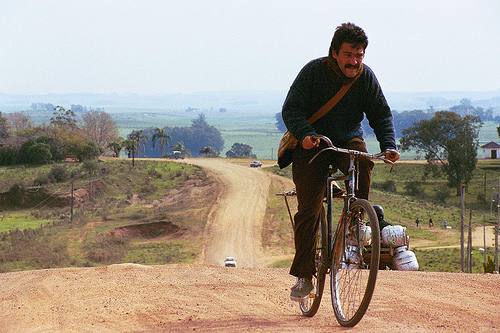El Bano del Papa
15In 1988 John Paul II and his famous Popemobile visited the small Uruguayan town of Melo. As it shares a border with Brazil, the locals of this poor, impoverished town anticipated a huge number of visitors and so prepared for what they hoped would be a great opportunity to make money.
Beto (César Troncoso) and his merry band of bicyclists travel to and fro from Brazil on a regular basis, smuggling booze and other contraband to their hometown. The problem is the border patrol, who in their truck, often round up the smugglers like wayward sheep. He dreams of getting a motorbike with which to outwit the border patrol with. However, his current finances can’t stretch that far.

Peloton meets Popemobile.
With news of the Pope’s visit though, he sees a unique way of making enough cash for his dream bike – to build a loo for the mass of visitors to their town of few public amenities, and to charge them for the privilege of using it. However, turning poos into pesos isn’t as easy as he thinks it is.
First time directors Cesar Charlone and Enrique Fernandez (who, incidentally, was actually born in the film’s location of Melo) use the real life visit of his Papal-ness as a backdrop for their fictional character Beto and his porcelain plight. What they create is something akin to the best films produced by those crazy Italian neo-realists of the forties; in particular, Vittorio De Sica’s beautiful classic The Bicycle Thief – and not just because of the bike theme.
Using a lot of handheld cameras, the pair capture a sense of real hope from a community that is used to anything but. Through Beto and his family, they channel the whole town’s optimism over the Pope’s visit, and with it the chance of some kind of prosperity.
Also like many of those neo-realist films, El Baño del Papa may not be the quintessential feel good film, but perhaps more importantly, it will make you feel so many more emotions on top of that.
